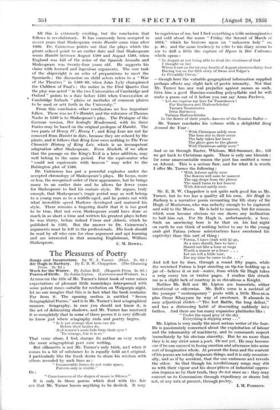The Date of Hamlet
THE problem of Hamlet, which Dr. Cairncross assails in this fascinating book, is not the old problem of Hamlet's character and alleged madness. He is concerned with the historical problem of the place of Hamlet in Shakespeare's development and especially with its date. The basis of his enquiries is the First Quarto, which was entered on the Stationers' Register in 1602 and printed in 1603. He accepts the view that this was a pirated edition, and that it was printed from a trans- script made by the actor who had played Mareellus, who knew his own part well, remembered best the scenes where Marcellus played, and relied on his invention in other scenes where his memory failed. Dr. Cairncross is particularly concerned with the last. He gathers the passages where the First Quarto differs from the Second Quarto of 1604 and the First Folio of 1623. Many of these passages he considers to be un-Shake- spearian, and with reason. For with extraordinary detective skill lie has run them down in other authors, in. Kyd's The Spanish Tragedy, Marlowe's Edward II, Chapman's A Humorous Day's Mirth. Others he traces to The Merry Wives, Henry and King John. The explanation is that the pirate acted in these plays, and when his memory failed or deceived him in writing out his text of Hamlet, he supplied deficiencies from other plays which he knew. All this is extremely exciting, but the conclusion that follows is revolutionary. It has commonly been accepted in recent years that Shakespeare wrote Hamlet some time after 1600. Dr. Cairocross points out that the plays which the pirate echoed point to an earlier date and that Shakespeare wrote Hamlet between August 1588 and August 1589, when England was full of the noise of the Spanish Armada and Shakespeare was twenty-four years old. He supports his claim with learned and ingenious arguments. The sore task of the shipwright is an echo of preparations to meet the Spaniards ; the discussion on child actors refers to a " War of the Theatres in 1588-89, when John Lyly championed the Children of Paul's ; the notice in the First Quarto that the play was acted " in the two Universities of Cambridge and Oxford " points to a date before 1593 when Convocation at Cambridge forbade " plaies or inerludes of common plaiers to be used or sett forth in the University."
From this conclusion other conclusions no less important follow. There was no Ur-Hamlet, and the reference of Thomas Nashe in 1589 is to Shakespeare's play. The Prologue of the German version, Der bestrafte Brudermord, with its three Furies may be based on the original prologue of Hamlet. The two parts of Henry IV, Henry V, and King Lear are not far removed from Hamlet in date, because they are echoed by the pirate, and it follows that King Lear owes nothing to The True Chronicle History of King Leir, which is an incompetent adaptation after Shakespeare. Even Macbeth, if we allow that the passage on the King's Evil is a later addition, may well belong to the same period. For the equivocator who "could not equivocate with heaven " may refer to the Babington plot of 1586.
Dr. Cairneross has put a powerful explosive under the accepted chronology of Shakespeare's plays. He keeps, more or less, the recognised order of their appearance, but he brings many to an earlier date and he allows far fewer years for Shakespeare to find his mature style. He argues, truly enough, that Shakespeare's tragic period may as well belong to a young man as to a middle-aged, and he points out with what incredible speed Marlowe developed and matured his style. There remains a lingering doubt that it is too good to be true, that not even Shakespeare could have done so much in so short a time and written his greatest plays before he was thirty, before indeed Venus and Adonis, which he published in 1593. But the answer to Dr. Cairneross's arguments must be left to the professionals. His book should be read by all who care for close argument and apt learning and are interested in that amazing Englishman, William







































 Previous page
Previous page